Tour of Egypt
Outside the oases grows literally nothing
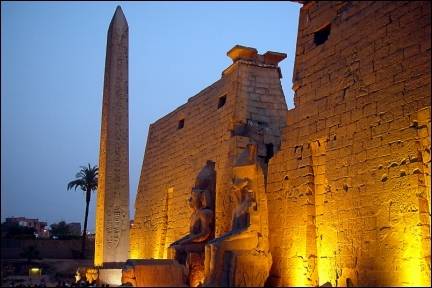
|
Besides cultural highlights like the Egyptian Museum, the pyramids and temples, Egypt has impressive landscapes: desolate white and black sand, lime and basalt deserts with bizarre rock formations. Outside the Nile delta and the oases grows literally nothing.
Travelogue & photos: Johan Siegers
After our arrival in Cairo, we and our guide Houssam, together with other tourist groups, are driven to downtown Cairo in a convoy with police escort. It seems a little exaggerated, but since the terror attacks of 1997 this is standard procedure. There still is a group which tries to hurt the government through the country's most important source of income: tourism.
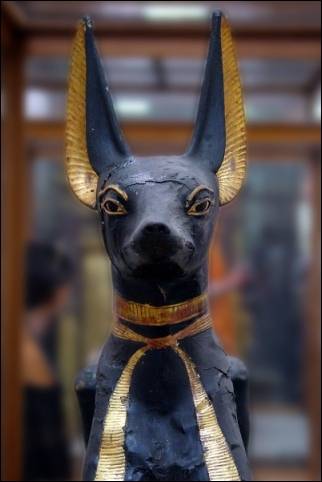
|
It is allowed to take pictures or make video recordings in the Egypt Museum; but a ticket for a video camera is ten times as expensive as one for a photo camera. There is a short argument whether my digital photo camera is a video camera, but I succeed in convincing them that it's a photo camera.
On the second floor are Tut Ank Amun's death mask and a large collection of uncovered statues. There is a separate entrance fee for the mummy room, but it's disappointing.
On the first floor are many large statues and sarcophaguses. It is estimated that it would take six months to see everything in the museum. It is huge, indeed, but after two hours everything begins to look alike. I'm through with the museum.
Cairo
Every street in the souk has its own kind of merchandise
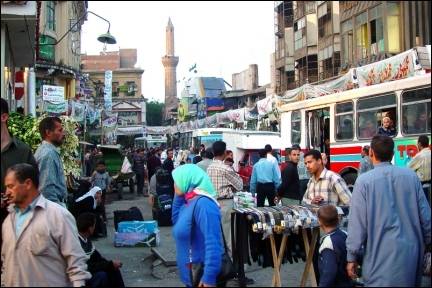
|
We take a cab with five people to the market at Souk Mansour, a maze of narrow streets where all and sundry is sold. Much is catered to tourists, but there is also merchandise for the Egyptians themselves: shoes, hookahs, there even is a street where safes are sold.
When we walk back, we pass cigarette vendors who also sell a strange kind of hollow white sticks. It turns out to be candy. I buy a bag for a pound. They taste a bit like cinnamon.
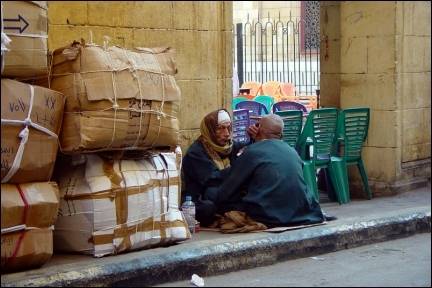
|
Traffic is chaotic in Cairo. Crossing is an art. One has to find a space between cars and then cross lane by lane. It reminds me of a computergame in which one has to guide a frog through lane after lane of moving traffic.
The difference is that the lanes in Cairo are not as clearly indicated. There are painted lines, but those are often ignored. The same goes for red traffic lights.
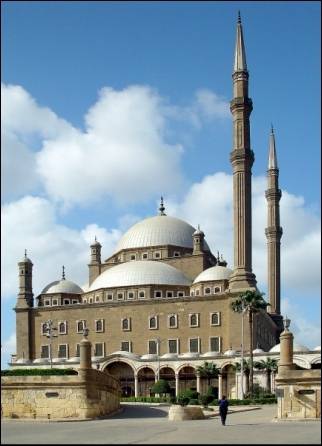
|
Parked cars sit literally bumper to bumper. We see someone who wants to leave, push the cars behind his own out of the way. There is a lot of police in the streets. Sometimes as much as three cops per intersection. Many wear a sign "tourist police." Egypt has compulsory military service and draftees can choose between 2 years in the army or three years in the police force.
We want to visit the old city, but are not allowed to enter. There is a demonstration against the American support for Israel. As a precaution, the police have closed the old city for tourists.
The Citadel is accessible, though that is a relative term here. In many places we're stopped and sent back. The Mohammed Ali mosque and two museums are open, though.
We try to walk back through the Islamic district and end up in the City of the Dead, as the northern cemetery is called. There are real houses for the dead here. It looks like a deserted town, but if you look inside the houses, it becomes clear that there are graves inside. Egyptians visit their dead relatives here and have dinner and sleep in the houses.
Saqarra
Stooped down a ladder to the burial chamber
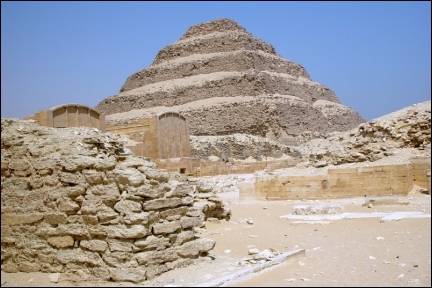
|
The city of the dead Saqarra was built in the desert to be able to optimally use the fertile Nile valley for agriculture. Kings and other VIPs were buried here. It is also the site of the first step pyramid, commissioned by pharao Djoser.
Legend has it, though, that after Djoser was buried, his grave was covered with a large stone. But from a distance, it wasn't visible. So a second layer of stones was added. But the grave still was invisible from a distance. Only the sixth layer of stones marked the grave sufficiently. And thus the step pyramid came into being. At least, according to legend.
The outer layer originally was limestone. But over the ages the limestone crumbled off, or was stolen by the local population to build houses.
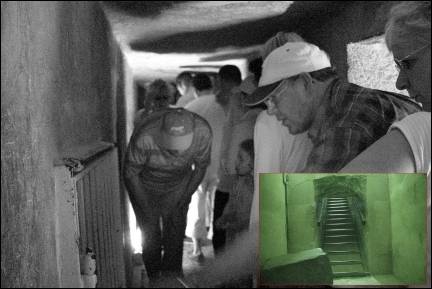
|
Because we can't enter the Djoser pyramid, we visit the Teti tomb. We have to climb down, stooped, via a rickety ladder until we arrive in the burial chamber.
We visit the Gizeh plateau, with the Cheops (Khufu), Chephren (Khafre) and Mycernius (Menkaure) pyramids, for father, son and grandson. We enter the Khafre pyramid and have to walk stooped through a 1.5 meters high, descending corridor. Leaving visitors seem relieved and say: "Ah! Air!" which doesn't help to improve my mood.
With every step it gets hotter and muggier. Two English girls in front of me return when we're half way, they can't take it any longer. We arrive at a level floor where the ceiling gets lower as we proceed. Then we go up again. We arrive in the burial chamber, which contains a sarcophagus and an Egyptian who constantly, in a loud voice, tells us what we see and also collects bakshees (tips).
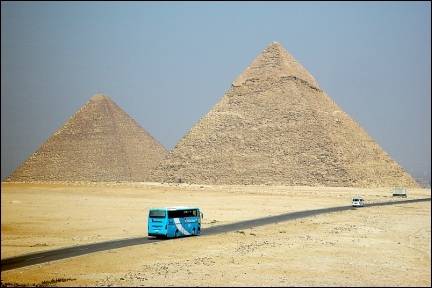
|
Near the pyramids is the Sphinx. It has the body of a lion and Chephren's face. An argument about the creators of the Sphinx ensues with the guide.
We heard on Discovery Channel that the Sphinx was possibly made by an even older civilization. The guide denies this, because there never have been found traces of an older civilization. But it is uncertain whose face is represented by the head of the Sphinx and why it is not aligned with the three pyramids.
In the evening we have dinner in a small restaurant with our group. They don't have a menu. We get a dish of rice, macaroni and lentils. It looks strange and I would never have picked it if Houssam hadn't recommended it. To get us cans of soda, the owner has to run to the local supermarket.
Desert trip
A desolate landscape with sand and black basalt
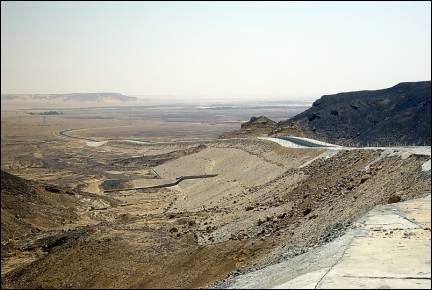
|
A van takes us to the Bahariyya oasis in four and a half hours. An armed policeman travels with us for our security.
Outside Cairo everywhere new suburbs are being built to lure people out of the city. Young people don't want to leave Cairo, though, because it offers the best chance to find work.
The road to the oasis is bumpy. In several places people are busy asphalting the road. In the oasis the van is exchanged for two jeeps, which take us into the mountains. This part of Egypt is mainly sand and basalt. The black basalt gives the landscape a desolate look. Literally nothing grows here.
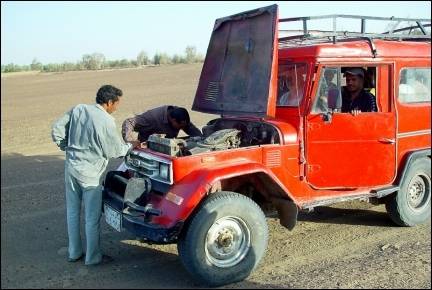
|
Frequently one of the two jeeps breaks down. We think it is on purpose, but when they start looking worried after the second jeep won't start, we are convinced that the jeeps really are just in bad condition.
When the second jeep breaks down completely, ours tows it, with a rope that we think is way to thin. We're afraid it'll tear any minute. Miraculously though, everything goes well and we arrive at the place where we'll spend the night. It is a small settlement with simple cabins for tourists.
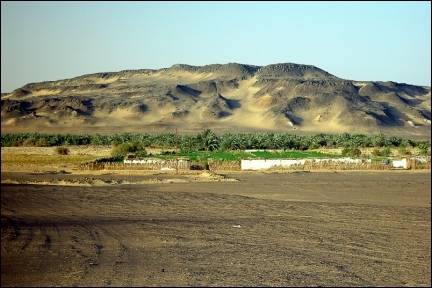
|
Next day we continue our jeep drive through the oasis and the villages within it. It feels as if our driver is the village fool. He specializes in unexpectedly taking sand hills at full speed. But the jeeps are performing much better today: they break down only twice.
The trip takes us along Crystal Mountain. The mountains here consist of clearly visible crystals. I find a few pretty specimen as souvenirs.
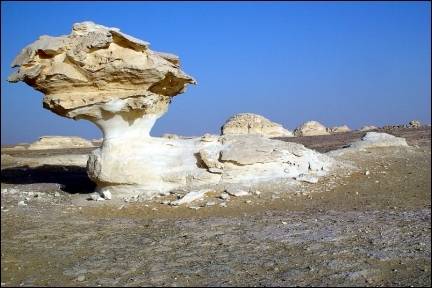
|
Our destination today is the white desert. It owes its color to the limestone in the ground. Above ground, several bizarre shapes, polished by the sand, stick out. With some imagination, mushrooms and a dromedary can be recognized in them.
We walk through this bizarre moon landscape toward a higher-lying spot, where we hope to see the sunset. At the last moment, however, clouds spoil our fun.
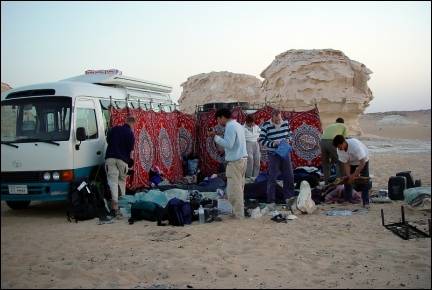
|
By six in the morning I wake up in my sleeping bag in the white desert. Some of my travel companions are already up and about. I am awake in time to see the sun rise.
On the way to the Dakhla oasis, we pass the ruins of the deserted village El Qasr. The houses are made of unbaked clay which was dried in the sun. It possible to use them for the construnction of houses because it hardly ever rains here.
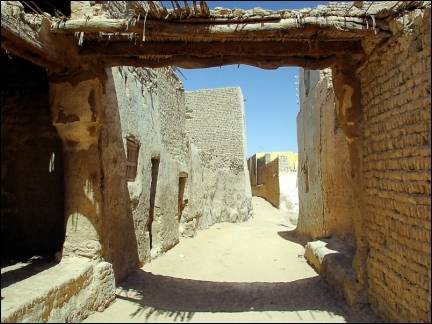
|
El Qasr gives an impression on how people used to live here in the past. Women had to stay indoors and take care of the children.
The small windows have bars through which one could look outside. The woman had to make sure that no one would see her face. If that happened, and the person who saw it told her husband, he could divorce her, because she wasn not a good woman. She had shown her face to another man.
We spend the night in the Bedouin village el-Dehouze. The cabins are made of reed. At least we can take a shower here, which uses water from a tank on the roof of the concrete building. As we're traveling south, it's becoming hotter. In the afternoon, the temperature is now approximately 35 degrees centigrade.
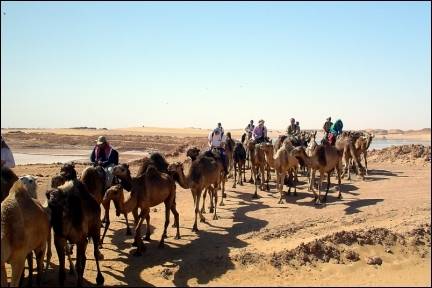
|
From where we sleep, we walk to the camel "stable": we're going to take a camel ride. All camels join, not only the ones that carry us. There are a few young also. The camels smell bad. Maybe because some of them have been rolling in shit, judging from the way they look.
After one and a half hours we arrive at a natural hot water spring. Here we can swim. At the center of the pool, the water comes bubbling up. It doesn't have a bottom, but the power of the water pushes us up. The water temperature is 28 degrees centigrade and the water is ferrous. At the rim of the pool everything is brown because of the iron.
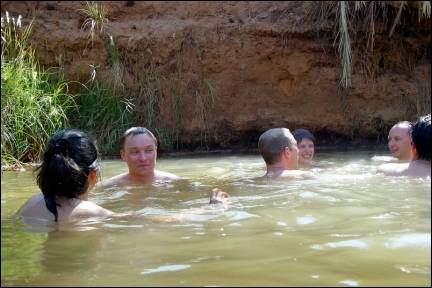
|
At places where one can stand, there is quicksand. One sinks into it up to the knees. When we leave the water, our feet are brown because of the iron.
In the afternoon we continue our trip by bus. Our route takes us to the Hebis temple in the Kharka Oasis. This Persian temple is threatened by groundwater. In an attempt to save the temple, they began to break it down and build it up 5 km away. After three years they found out that it was impossible to rebuild it in the new spot. So the part that was already moved to the new spot was brought back to the original place. They're still trying to find a solution for the groundwater problem.
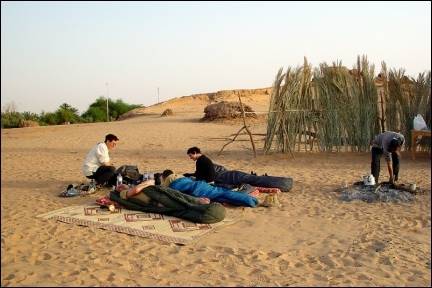
|
We spend the night in a village, Prevda. We sleep in tents on a large sand plain in the oasis. At night, it's muggy, so some prefer to sleep outside their tents.
Luxor
Almost all walls have hieroglyphics
From Al-Kharga oasis it's 350 km to Luxor. We drive on a formerly military road. When we arrive in Luxor around noon, we first take a shower and have the hotel wash our clothes. Then we visit the hotel's rooftop swimming pool.
As soon as it gets a little cooler by the end of the afternoon, I pay a vist to the Luxor temple. Actually, it's a temple compound. It currently is 1500 meters long, but including the original access road, it was 3 km long. The temple wasn't built all at once and therefore it displays different architectural styles. Almost all walls and column have hieroglyphics. Some were painted, but their color has faded over the ages.
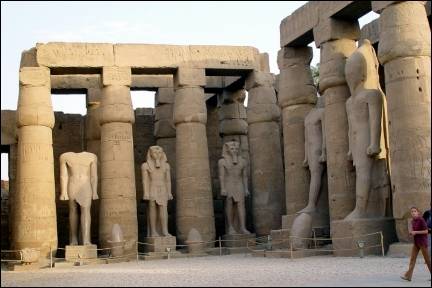
|
There are stray dogs on the temple grounds. When the call to prayer is sounded from nearby minarets, they all bark. Islam is not for dogs.
The mummification museum has a small collection, but big entrance fees. Especially the fee for bringing in a digital camera is way too high for me. The museum itself is nice, with human and animal mummies. There is also a display of tools that were used for mummification, like a knife to make an opening in the skull and a spoon to empty its contents.
Valley of the Kings
Thanks to lazy diggers, Tut Ank Amons tomb was never looted
Before we visit the Valley of the Kings, we make a visit to the temple of queen Hatshepsut. A female pharao was very unusual. She succeeded in becoming one because her nephew was only 9 years old when he should have ascended the throne. She sent him to a school/prison and took over power herself. She dressed like a man, including a false beard.
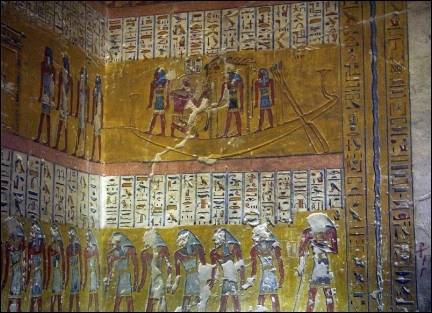
|
In the sweltering heat we next visit the Valley of the Kings. We look at the three tombs. One is only half-completed, another is long and deep and the third has beautiful murals.
The Valley of the Kings is also the location of the tomb of Tut Ank Amon. It is one of the few that hasn't been looted, thanks to the laziness of the diggers of the Ramses VI tomb. Instead of moving the dug-up rocks out of the valley, they dumped them on Tut Ank Amon's tomb, thus hiding it from grave robbers.
Near the Valley of the Kings is the Deir Al Madina temple. It is special because the engravings of the walls are very deep. In some spots even hand-length deep.
We take the ferry to the other side of the Nile and after some searching we find the restaurant that was recommended to us. All kinds of vegetable dishes are put on the table. We can each choose two kinds of meat from a list, read out by the owner in a curious combination of English and French. It seems to me that the dishes are from different countries; in any case, it's all very tasty.
Aswan
In front of and behind the convoy, jeeps with armed police
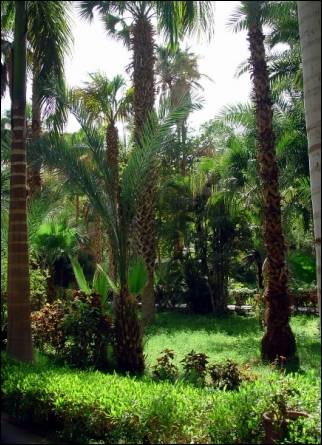
|
We leave Luxor for Aswan in the south of Egypt. This is only allowed in convoy, with police protection. The convoy leaves ver early, with armed police in front of it and behind it. Every time the chaotic driving style of the Egyptians threatens to get us stuck, the police turns on its sirene. Probably to get the attention of potential kidnappers...
In the afternoon we visit the botanical gardens on Kitchener's island, hoping it'll be a little cooler there. The gardens were laid out around 1890 by Lord Kitchener. They have plants from all over the world, but especially many palm trees. Between the plants we see birds, like the white ibis, cats and a few dogs.
We have dinner at home with a Nubian family. Lots of Nubians live in Aswan. With their dark skins they form a bridge between Egypt and Africa. They originally lived in the region between Aswan and Sudan, but this are was flooded when the Aswan dam was constructed. After dinner they show us beaded necklaces we can buy. But nobody is interested. Some of my travel companions have henna tatoos made, though.
After dinner we visit the souk (market), to look for T-shirts. Negotiating over prices isn't always equally successful. The vendors use their whole repertoire to get what they want.
Philae
The temple was literally pulled out of the water
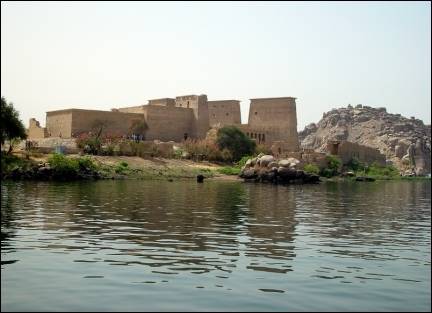
|
Today we rent a van with driver and guide to visit Philae island. There is a temple on this island which was literally pulled out of the water. After the construction of the Aswan dam, the temple disappeared under water.
Because, in hindsight, it was a pity, with help from abroad a dam was built around the submerged island, the water was drained, the temple sawed into pieces and a little farther (on Philae) put back together again.
It's a beautiful temple, but it is too hot to walk around. Today it's 39 degrees centigrade in the shade, temperatures which usually only occur in June. We are experiencing a little heat wave.
In the afternoon, when we're seeking some cooling at the pool, the wind increases. Looking at the sky, I see it's yellow because of the blown up sand from the western banks of the Nile. It gets so bad that I can look straight into the sun.
Felucca trip
Against the wind we manouvre on the Nile
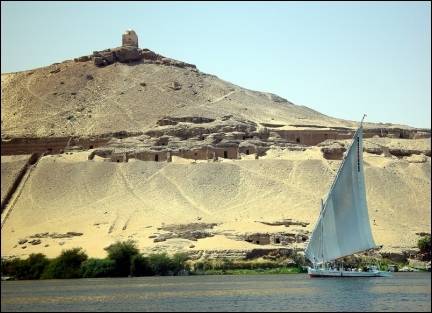
|
The same strong wind spoils our planned felucca trip with a traditional sailing boat with which people have navigated the Nile as long as human memory can remember. The tourist police doesn't allow feluccas on the Nile. We visit the Nubian museum while we wait for better weather.
Around noon the wind has decreased sufficiently to allow for an attempt to sail the felucca. We are moving against the wind, so we tack from one side of the Nile to the other. After a while it gets too dangerous and we dock at Elephantine island.
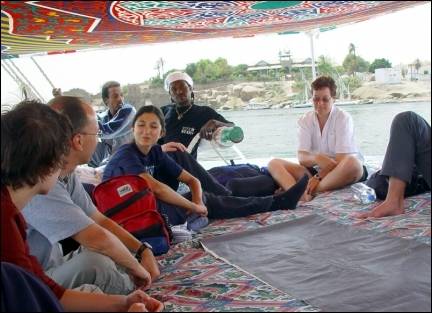
|
I take a short walk on the island and wander through a half-completed hotel. It's not more than a concrete skeleton. Everywhere pieces of reinforcement iron lie around. In a dark part a colony of bats has settled.
Because it's too late to sail to Kom Ombo, we sail to the Nubian village where the crew lives instead. Here we spend the night on board the felucca.
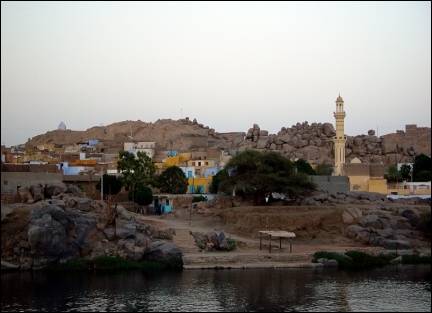
|
I noticed the minaret last night and, indeed, next morning at 4 the call to prayer wakes me up. We have to sail back to Aswan, because we can't miss our convoy to Luxor.
We acclimatise for a day in Luxor and then travel to Cairo by night train. Our vacation is over.